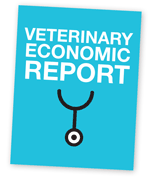Economic reports dig into the details
The AVMA is releasing a series of six reports, the 2015 AVMA Economic Reports, that dig into the economics of the veterinary profession.
The release schedule is as follows:
- January: AVMA Report on Veterinary Markets
- February: AVMA Report on Veterinary Employment
- March: AVMA Report on Veterinary Debt and Income
- May: AVMA Report on the Market for Veterinarians
- July: AVMA Report on Veterinary Capacity
- September: AVMA Report on the Market for Veterinary Education
 The AVMA is selling the reports as a series. The price is $249 for members and $499 for nonmembers. The series is available for purchase here.
The AVMA is selling the reports as a series. The price is $249 for members and $499 for nonmembers. The series is available for purchase here.
Out in January, the AVMA Report on Veterinary Markets contains findings from the Oct. 28, 2014, AVMA Economic Summit and provides an overview of the markets for veterinary services, veterinarians, and veterinary education.
Ross Knippenberg, PhD, economic analyst in the AVMA Veterinary Economics Division, said some of the key points in the overview include the following:
- The outlook for both the near and long term is improving for the veterinary profession as the U.S. economy begins to return to its longer-term growth trend.
- The market for veterinary education is at or very near equilibrium. As long as the ratio of eligible applicants to available seats remains above 1, and these eligible applicants are willing to pay the price per seat at which the colleges are willing to sell those seats, the supply of new veterinarians will remain equivalent to the number of available seats.
- The cost of veterinary education is forecast to increase at a rate exceeding the rate of increase in veterinary compensation. Thus, at some point, higher-priced seats will likely be left vacant.
- The market for veterinarians is not in equilibrium. The number of new veterinarians being absorbed into the profession is increasing faster than the growth in demand for their services. This is reflected in the flat trend in real incomes that began during the last recession and the increasing number of existing veterinarians at the lower end of the compensation range.
- Female veterinarians indicate they wish to work fewer hours, and the percentage of women in the profession is increasing. The combination could result in fewer veterinary services being provided per veterinarian.
- Excess capacity is the ability to provide services in excess of the quantity of services demanded at a specific price. The AVMA’s economists forecast constant class sizes of new veterinarians from 2018-2025 but a growing number of pets and increasing demand for veterinary services overall. As a result, excess capacity for veterinary services will decline.
Related JAVMA content:
Market improving, but value of veterinary degree unclear (Dec. 15, 2014)